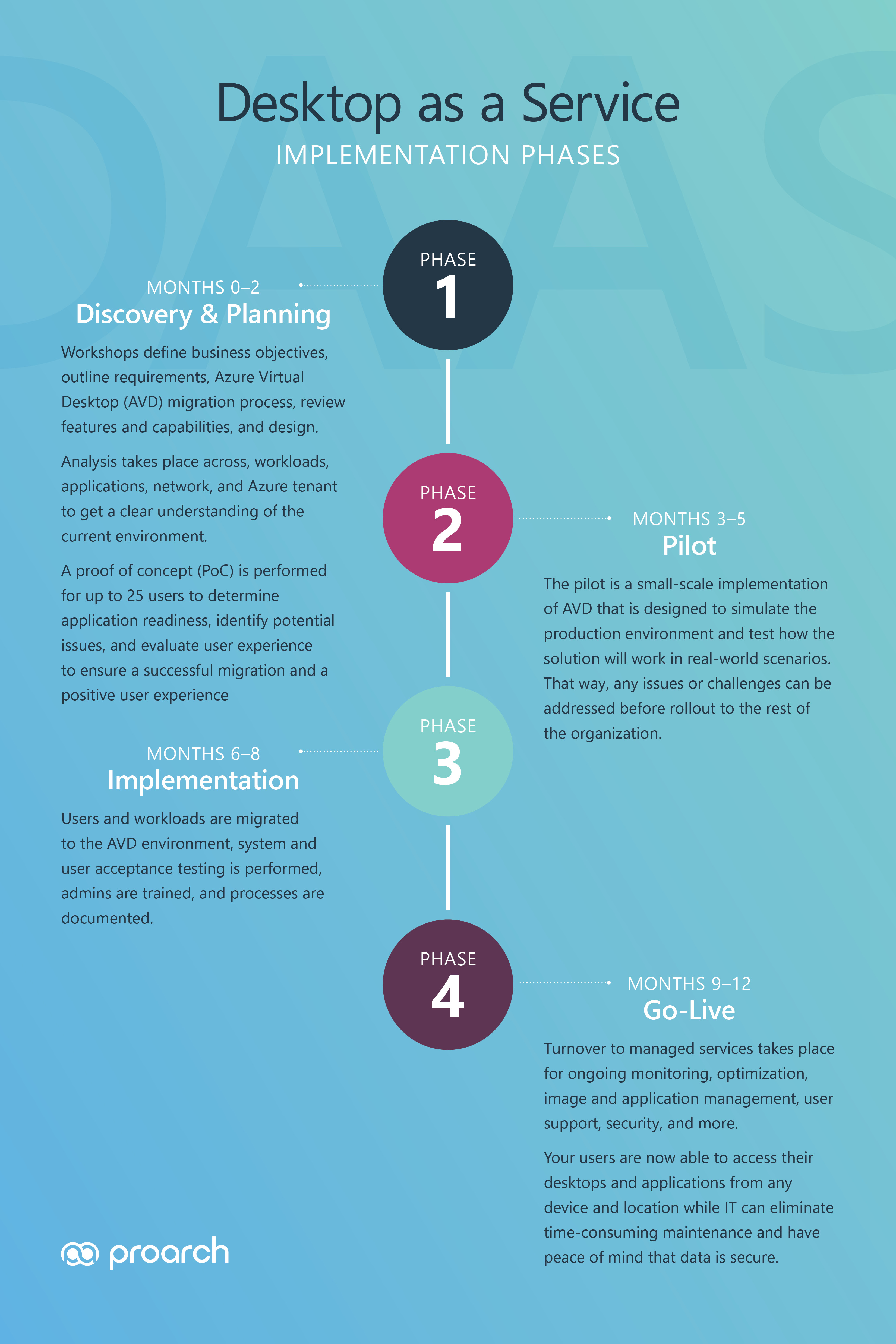Infographic: Desktop as a Service Implementation Process
Given the benefits of cloud computing, more and more leaders are implementing Desktop as a Service (DaaS) to migrate their servers and user desktop environments to the cloud through platforms like Azure Virtual Desktop (AVD). In fact, the Desktop as a Service solution industry is expanding at an 18.1 percent CAGR, with the market size projected to total nearly $18 billion by 2029.
But how does the Desktop as a Service process work? As a Desktop as a Service provider, ProArch’s DaaS involves four phases to full migration and implementation, which seek to remove hurdles, align with business objectives, and reduce risk. Let’s dive into the four steps of the Desktop as a Service implementation process.
Click here to enlarge infographic.
Phase 1: Discovery and Planning
In the first few steps of Desktop as a Service implementation, ProArch will work with you to define your business objectives, outline requirements, review features and capabilities, and prepare for the Azure Virtual Desktop migration process. First, the team will analyze your current environment’s workloads, applications, networks, and the Azure tenant. Then, the ProArch team will use this information to determine your organization’s application readiness, identify potential issues, and evaluate user experiences to ensure a successful migration based on best practices.
Phase 2: Pilot
Throughout the next phase, ProArch will launch a pilot of the virtual desktop infrastructure. A small-scale Azure Virtual Desktop implementation takes place to simulate the solution and test how it will work in real-world situations. This enables the team to address any challenges and document the success criteria in order to move forward with implementation phase.
Phase 3: Implementation
After the pilot, it’s time to start the implementation of Azure Virtual Desktop. In this phase, your ProArch Desktop as a Service provider will migrate users and workloads to the AVD environment, perform system and user acceptance testing, and document the process to ensure everything is ready for deployment.
Phase 4: Go-Live
Finally, in the last stage, turnover to managed services will take place to handle all ongoing monitoring, optimization, image and application management, patching, and upgrades. At this point, users can access their desktops and applications from any device and location.
Overall, the ProArch DaaS implementation process is designed to lay the best foundation for a successful Azure Virtual Desktop migration. In our proven process, you can upgrade your legacy systems to a cloud network that offers greater agility, improved capabilities, and more. For more details on the implementation process, view this document.
You don't have to go through a DaaS implementation on your own! Let ProArch do all the heavy lifting so you can reap the rewards- streamlined remote work and enhanced security.
If you feel like your VDI solution is holding you back, find out more about how a top Microsoft partner like ProArch can help your organization move to the cloud with confidence in as little as three months with Desktop as a Service.

Director of Marketing Rebecca leads ProArch's marketing efforts, seamlessly blending technology and storytelling to assist clients in their buying journey. She is dedicated to presenting technological solutions in a compelling manner that drives significant growth for the company. Collaborating closely with sales, engineering, leadership, and HR teams, Rebecca sets the strategic vision for ProArch and ensures alignment across the organization. Her strategic, visionary, and detail-oriented approach shapes ProArch’s brand to be synonymous with reimagining technology to achieve business objectives.

